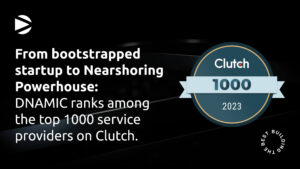Why I've had to let go of those who don't believe in Automation (and why I think you should too)
Table of Contents
Let me start by giving you the short of it:
- One aspect of my job that I absolutely detest is letting people go.
- When we are overly busy, the first thing we all give up is politeness, and most importantly…
- Being overworked inhibits creativity, so in my mind, the only way to maintain a human-driven and creative business was to free up our time by implementing the most advanced AI and automation technologies.
Let me now give you the complete picture:
In 2012, I was employed by a sizable American corporation and was a part of the finance sector. From data entry to transaction processing, our daily operations involved a large number of repetitive, time-consuming tasks that consumed a significant amount of our team’s time and resources. This was a time before AI-based solutions like ChatGPT, and the idea of automation was more a topic of speculation rather than implementation.
As a company, we were concerned about people in general and also gave careful consideration to our ability to meet the specific needs of each client. However, the increasingly burdensome administrative responsibilities were leading us towards an operational paradox. We had less time for cordiality and less time for innovative thinking, and yet we were busier than ever.
By 2014, I had made the decision to launch DNAMIC, a consulting firm with a strong emphasis on innovation and human touch. As a founder, the hours were long, but the challenge was interesting, so the enjoyment made it all worthwhile.
The eye opener
Fast forward to 2022, I witnessed a startling yet somewhat amusing scenario: IT managers, individuals at the forefront of technological advancements, were still manually taking down notes in meetings, even when voice-to-text technology had been available for five years.
There was a clear resistance to change. Despite the advancements in technology over time, I observed people in my own industry clinging to antiquated practices out of habit, fear, or uncertainty. This attitude was slowing not only their own productivity but also the expansion of the organizations they belonged to.
I’ve done my research and tried to learn as much as I can about automation’s future. AI development is anticipated to automate a number of IT tasks by 2030. Up to 70% of routine IT tasks could be automated by the middle of the 2020s, according to a Gartner prediction from 2020. Areas like network administration, cybersecurity monitoring, software testing, and system maintenance are expected to be impacted by automation. Automation may make these tasks more efficient, but it also highlights the need for IT professionals to improve their skills in order to take on more strategic and difficult problem-solving roles.
The message I’m attempting to get across to you (and my team)
This made it abundantly clear to me that adopting automation was no longer a choice but a necessity if I wanted to stay relevant and competitive. Automation, in my opinion, does not lessen the human touch; rather, it strengthens it by giving us more time to focus on our strengths as problem-solvers, collaborators, and creative thinkers.
Our efforts
Change management can be a challenging and complicated task despite our best efforts. As a business, we put a great deal of effort into this automation shift. We invested substantial capital in procuring the best AI and automation technologies available. In order to foster an environment where learning and experimentation were encouraged, we scheduled weekly research and development meetings. To ensure that our staff was knowledgeable about these new tools and technologies, we also hired top-notch trainers.
Nevertheless, some employees found the transition difficult despite the extensive support provided. For many people, change, especially technological change, can be frightening. The resistance was not due to a lack of opportunities or resources; rather, it was due to a reluctance to leave one’s comfort zone, despite the fact that we had established an environment that promoted learning and growth. This brought to light a crucial lesson for us: mindset changes require more than just having the appropriate tools or resources. It involves being receptive to new modes of operation and prepared to adapt and change.
The hard part
Letting go of employees who do not believe in automation was not an easy decision. It wasn’t that they couldn’t adapt; rather, it was that they weren’t willing to. The goal was to maintain and improve the organization’s capacity for being human-centered, cordial, and innovative. Without their support, I knew it would be difficult to make the shift to a more automated future, and our company’s development would remain stuck indefinitely.
The path to achieving this goal has been difficult for us, and I’m sure it will be for you as well. Nevertheless, I think it is critical to promote a culture that values change and encourages technological innovation. Being open to automation is not just about using new tools but also about adopting a new mindset. It is about realizing that by letting machines take over mundane tasks, we can focus more on what makes us human: our capacity for creativity, empathy, and innovation.
My Recommendations to you
I give you this thoughtful advice as you think about your journey toward implementing AI and automation technologies.
First and foremost, it’s crucial to understand that this change represents a cultural metamorphosis rather than a change in technology alone. Encourage a culture where change is welcomed and seen as a means of personal and professional development rather than as a threat to be feared.
Next, making wise investments in thorough training is of the utmost importance. It may be difficult for your team to unveil new technologies without a thorough understanding. Engage experts to share their knowledge, hold thorough workshops, and make sure ongoing support is available. The objective is not only to understand the mechanics of these technologies but also to appreciate their impact on our work lives.
I urge you to show patience and perseverance. Transformation is not an instantaneous process—it takes time. Resistance and setbacks may occur, but they’re simply stepping stones on your journey to automation. Remain steadfast in your commitment, maintain open communication lines, and continue to offer support. As the benefits of automation gradually become apparent, acceptance will replace resistance. Remember that the ultimate goal is to improve human creativity and interaction, not replace it.
Finally, don’t be afraid to make the necessary decisions.
The bottom line
Embracing automation is not just a technological shift but a strategic one. It is about realizing that to continue being human-driven and creative, we need to be willing to evolve with the times, adapt to new technology, and let go of outdated practices. I hope this sparks a conversation in your organization and prompts you to take a critical look at your automation readiness. After all, the future belongs to those who are prepared for it.
By Arturo Garcia,
DNAMIC CEO & Co-founder
IT Services automated with love
Learn more about our services!
Or contact us directly! Ask away!
And we will have the perfect role for out-of-the-box thinking developers ready to change the game and enhance your business to new heights.


